Ganesha Puzzles
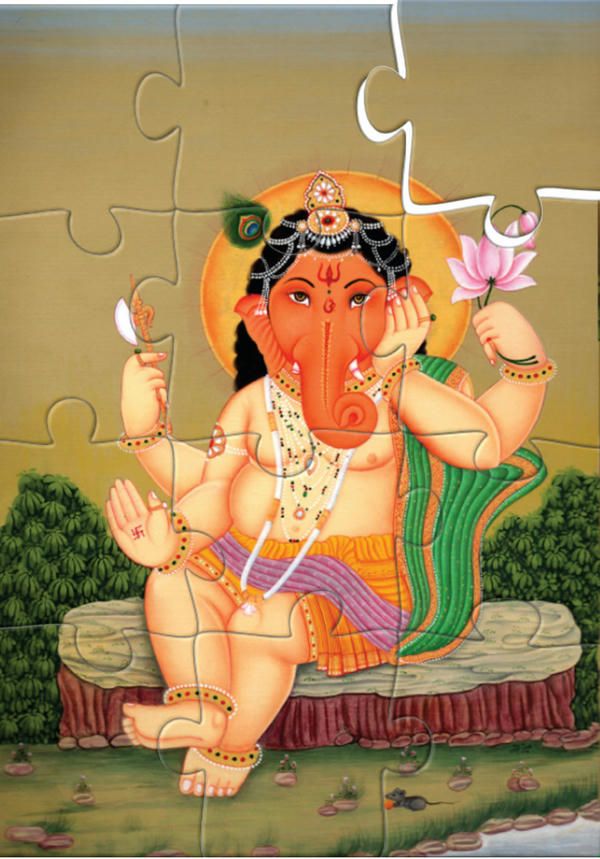
THE PLAYFUL, POWERFUL CHILD OF UMA IS BALA Ganesha, one of Lord Ganesha’s favorite forms. Here we venture a few forays into the world of high-minded fun and wordful frolic. Enjoy. This is playful svadhyaya. Svadhyaya is a key concept in Hinduism, one of the classical yamas, or cardinal guidelines of conduct, expounded by the ancient Natha Aishi Patanjali and others. It is the deliberate focused activity of self-upliftment through scriptural study, memorization of holy verses, reading elevating tales of spiritual giants and listening to religious discourses. We use our time involving the mind and intellect in pursuits that lead us onward toward the goal of moksha, rather than dispersing consciousness through pointless ramification. But it need not be all so serious. For children and youthful minds, play can also be svadhyaya — recreation that fills the mind with religious impressions. Hindu art and culture overflows with an unsurpassed richness of spiritual play. This chapter is a small contribution to that vast river of dharma’s fun and games.
Lord Ganesha rules the muladhara, the chakra of memory. Yogic insight shows that memorization of spiritual teachings, chants and concepts, a seemingly mere rote process, in fact works a transformation of the energies of the muladhara. We actively remold the contents of the subconscious, refining the nature, sublimating and transmuting instinctive energies. May these few games invoke and indelibly stamp upon our minds the great teachings and culture of dharma held in the mind of our beloved Lord Ganesha. Seers say even heavenly devas delight in word play of a spiritual nature.
The Puzzle of the Guardian of Bharat
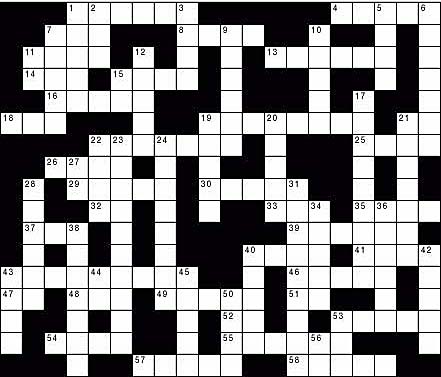
Across
1. Sacred syllables chanted by Hindus.
4. The chakra that Ganesha sits upon is a four-petalled ______ .
7. Ganesha’s vahana (vehicle)
8. Ganesha is full of _____.
11. ______ fields are sacred to Lord Ganesha.
13. Ganesha is sometimes called the Lord of _______.
14. Ganesha is very ____.
15. Ganesha has four _____.
16. Ganesha uses a _____ and a goad to help him do his work.
18. Divine servant. Used at the end of a devotee’s name.
19. What you say to Ganesha when he answers your prayer.
21. A Siva temple facing ___ is a fire-temple. (Abbreviation!)
22. The God we always worship first.
25. Hindus pray to Ganesha to ___ them in good and happy ways.
26. Ganesha loves all the animals in all the _____ in the world.
29. Ganesha works slowly and patiently, never in _____.
30. The Ganga is a sacred _____ to all Hindus.
32. Twice.
33. Hindus worship Ganesha with ___ and yellow flowers.
35. Another name for Vishnu.
37. Ganesha is even brighter than the ____.
39. Ganesha’s favorite sweet.
40. _____ gather honey from flowers.
41. Ganesha always makes careful decisions, never a ____ decision.
43. Kailasa is in the Himalayan _________.
46. The lower instinctive mind, seat of desire and governor of sensory and motor organs.
47. Ganesha pujas start as early as 3:00 __ in the morning.
48. Ganesha is Lord Siva’s eldest ____.
49. Indian variety of basil often used for japa beads.
51. Having two.
52. First two letters of the number of most famous Ganesha temples
in Maharashtra.
53. Kolam designs are ______ on the floor in front of Ganesha shrines.
54. Ganesha pujas fill you with ____.
55. Ganesha’s ______ flows through our minds and all form.
57. Indian women wear _______.
58. Incense has a beautiful ______.
Down
1. The fruit Ganesha won in a contest with his brother.
2. Ganesha ___ too many modaka balls one day.
3. Gifts to the poor and crippled.
5. Devotees who are having a special Ganesha archana often carry their offerings on a ______.
6. Ganesha _____ the Mahabharata with one of his tusks.
7. The monsoons of Southeast Asia bring severe tropical _____.
9. The traditional Hindu wedding is called a _________ ceremony.
10. Just looking at the murti of Ganesha makes you feel _______.
11. First and last letters of bean pod that tastes like chocolate.
12. Cane fields are _______.
15. Ganesha is known __ the Lord of Obstacles.
17. The big chakra that Ganesha sits upon deep in the microcosm.
19. Lord Ganesha lives in the _____ World.
20. Ganesha _______ forgets the prayers of His close devotees.
21. Hindu holy scriptures in Sanskrit.
22. The weapon Ganesha uses to knock obstacles out of our path and spur us onward.
23. A big word for “help.”
24. Ganesha has the head of an _______.
27. OH.
28. Ganesha always knows how to answer our prayers just right because His ________ is so great.
31. Ganesha’s memory is so great He _________ things that happened millions of years ago.
34. Indian thin flour pancake.
36. The subtle inner ethers.
38. When Murugan tried to win the contest with His brother, He flew around the world _______.
40. Ganesha’s _____ is bigger than any computer in the world.
42. The nagaswara and conch are two types of temple _____.
43. Lord Ganesha is a ____deva.
44. The first two letters of the first
digit on your foot.
45. Ganesha likes a lot of ______ in His sweet goodies.
50. Even though Ganesha has little eyes, He still ____ everything.
53. Many different organic substances are used to ___ the beautifully
colored Indian fabrics.
56. The first initial of Siva’s
two sons.
The Puzzle of the Lord of Dharma
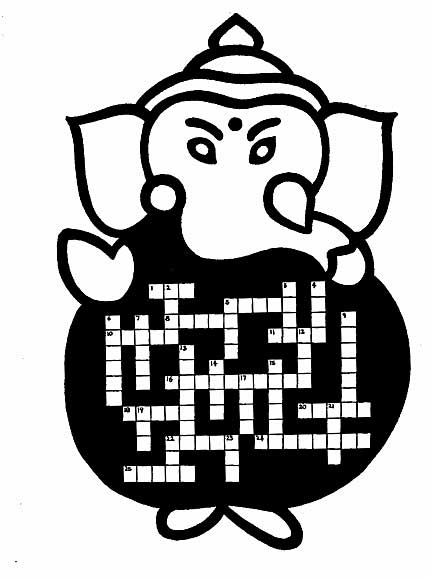
Across
1. Lord Ganesha’s seed mantra.
5. Good karma, righteous action, merit.
8. Eternal, something which should be done without fail always at the right time.
10. The second goal of human existence, wealth.
11. The first goal of human existence, love, pleasure.
16. “Demon place.” Hindu concept of hell; lower realm of the Second World in which souls temporarily experience self-created hellish states of mind.
18. What you are when you always follow dharma. A person good enough to go to the temple and do puja.
20. Our most important scriptures.
22. The inert, dark, heavy, dull, ignorant quality of nature.
24. A hall, generally in a temple or monastery.
25. Same as moksha.
Down
2. The third-eye chakra.
3. Spiritual practice of devotedly repeating a mantra, generally a specified number of daily repetitions while counting on a mala.
4. A name of Supreme God as “The Auspicious One.”
5. Bad karma, sin, wrong-doing.
6. A pot of water on which a husked coconut is nested on five mango leaves.
7. The soul.
9. Lord Ganesha’s vahana, the mouse, traditionally associated with abundance.
12. Delusion, fascination with and attachment to material existence.
13. Individual or group singing of devotional songs, hymns.
14. Rosary for performing japa, recitation of holy names.
15. A round sweet goody made of rice, coconut, sugar, etc. Esoterically, it corresponds to siddhi (attainment or fulfillment) the gladdening fulfillment of pure joy.
17. The Deity of fire.
19. The Primal Sound.
21. The name of the light that is waved during puja.
22. That, pure Being.
23. Immanent Truth.
The Puzzle of the Fruit of Truth
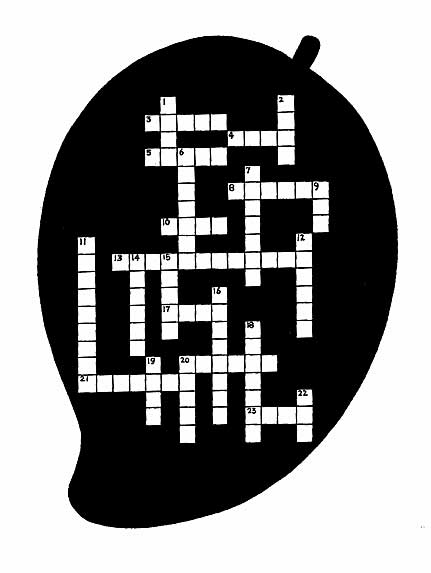
Across
3. Same as moksha.
4. Merging the individual mind with the universal mind of God within.
5. Peace.
8. A Mahadeva, or great God, created by Lord Siva to assist souls in their evolution. The elephant-faced Patron of Art and Science, first son of Siva, Remover of Obstacles.
10. Teacher, guide, remover of darkness.
13. Loving Ganesha holds a sprig of this wish-fulfilling tree to tell us that all our wishes will be gratified. We have but to tell Him our needs, that is all, just tell Him.
17. Loving Ganesha has this snake as His pet. Many are afraid of such creatures, but He tells us that it is the kundalini within all and each one can rise above all adversity.
20. Symbolic hand gestures used in puja, dance and hatha yoga .
21. Dedicated striving and practice.
23. A stringed instrument with two round dried pumpkins on the ends, that makes heavenly music.
Down
1. A period of time that spans many ages.
2. Loving Ganesha uses this instrument to prod the lazy ahead in their birth karmas whenever they tarry.
6. “Without qualities.” Refers to the Absolute God, Parashiva or Parabrahman.
7. “Accomplished or skillful one.” Someone who is dedicated to spiritual practices is usually celibate, wears white and is not a sannyasin.
9. Loving Ganesha knows there are difficult times ahead for some of His devotees. He protects them with this implement in gentle ways from evils they have attracted.
11. Householder; family man or woman. The period of human life after brahmacharya, or studentship, is over, the individual establishing of a career, home and family.
12. The calm, quiescent, peaceful, still quality of nature.
14. A word meaning “of the stars.” Anything in the subtle non-physical dimension of the Second World.
15. Primal life force of the breath.
16. “Great Deva” or “Great Shining One.” A name of Siva.
18. The symbol and mantra denoting God and the Primal Sound.
19. Loving Ganesha uses this implement to cast karmas back on devotees for resolution, never letting up until completion.
20. Loving Ganesha tells of this fruit: “It was given to Me from Lord Siva’s own hand after performing My first wisdom act. It represents the highest spiritual fruition.”
22. It’s hot in summertime, so Loving Ganesha sits whisking away the past within the minds of devotees with this cooling device.
The Puzzle of the Lord of Spiritual Mysteries
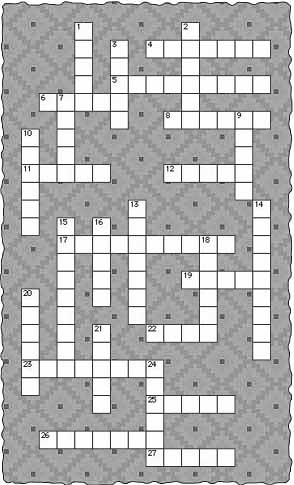
Across
4. Faith.
5. Loving Ganesha, like His brother Murugan, holds this great power. It flashes in the sky during storms, Spirit over mind, mind over matter.
6. “A “not spiritual” being living in the Second World on the lower astral plane, sometimes called a “demon.”
8. The animal that each Hindu God is depicted as riding on, symbolic of a function of the God.
11. “God.” Can refer to the image or murti installed in a temple or to the Mahadeva whom the murthi represents.
12. A troop of devas, especially used in reference to Lord Siva’s attendants under Lord Ganesha’s supervision.
17. The last portion of the Vedas. They teach philosophy through people asking questions and wise rishis’ giving answers.
19. Loving Ganesha broke this, His beautiful right tusk in a sacrificial act, using it as a stylus to get the job done. By this act He demonstrates that what we begin we must finish.
22. Inner plane being of light.
23. The ancient Hindu symbol of auspiciousness and good fortune. A Square cross with broken arms.
25. The fiery, restless quality of nature.
26. A sweet nut from a palm tree hard as a rock, but soft and white Inside.
27. What He shoots from his bow.
Down
1. Small circle of red powder (kunkuma) placed between and just above the eyebrows. It symbolizes the opening of the third eye, seeing with superconscious soul vision.
2. Loving Ganesha edits all these scriptures on this and other planets.
3. Sacred art of “drawing” intricate decorative patterns at the entrance to a home or temple or at ceremonial sites with the rice powder or colored powdered pulses.
7. Hinduism’s revealed scriptures.
9. Loving Ganesha uses this rope-like device to draw close those He loves and save strayed ones in extraordinary ways.
10. Spiritual attainment or power, superconscious abilities, fulfillment.
13. Triple-pointed lance representing Siva’s three-in-one power: Love, Wisdom and Action.
14. Loving Ganesha sits at Lord Siva’s holy feet with japa mala made of these seeds.
15. The chakra located at the base of the spine and governing memory, time and space where Loving Ganesha sits inside each person.
16. Sanskrit word meaning “deed or act;” the principle of cause and effect. Also, the totality of our actions and their concomitant reactions in this and all previous lives.
18. Divine law; the law of being; the way of righteousness or “that which holds one’s true nature.”
20. Loving Ganesha makes us grow healthy food by the desire for this simple underground vegetable.
21. Loving Ganesha wants us to be like this flower that “comes from the depths of the mud opening into the bud high above the water’s edge.”
24. The nectar of immortality that Loving Ganesha keeps in his pot.
The Lord Who Is Hidden in All Things
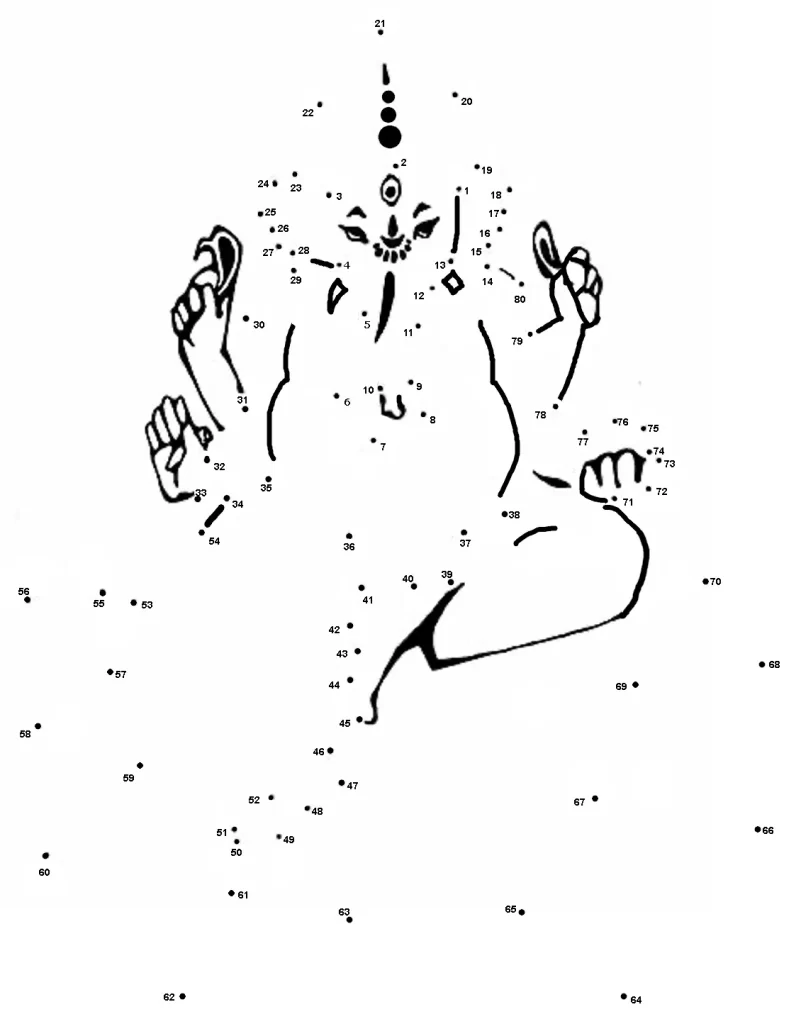
Solutions to Puzzles
Solution for the Guardian of Bharat
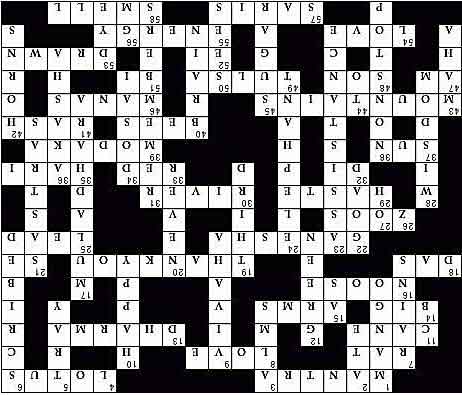
Solution for the Puzzle of Dharma
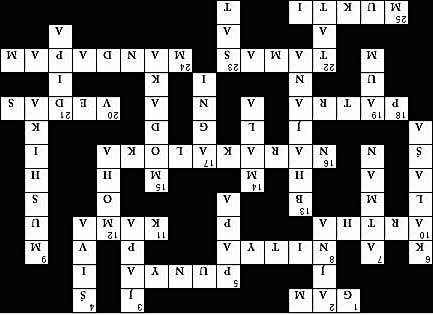
Solution for the Fruit of Truth
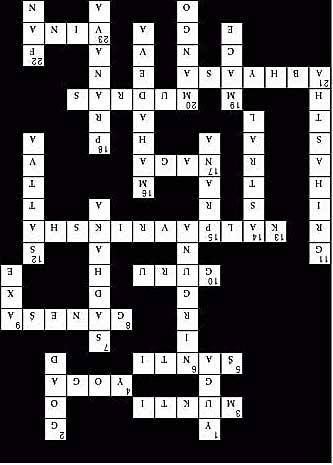
Solution for the Lord of Mysteries
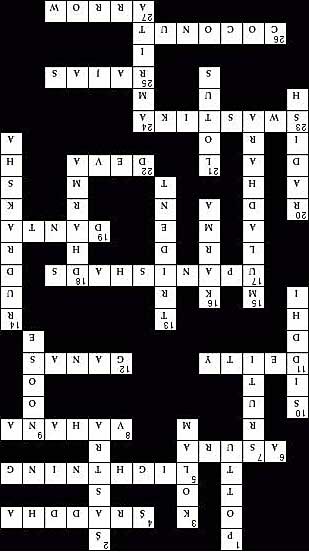
**Credits to and published by Himalayan Academy

